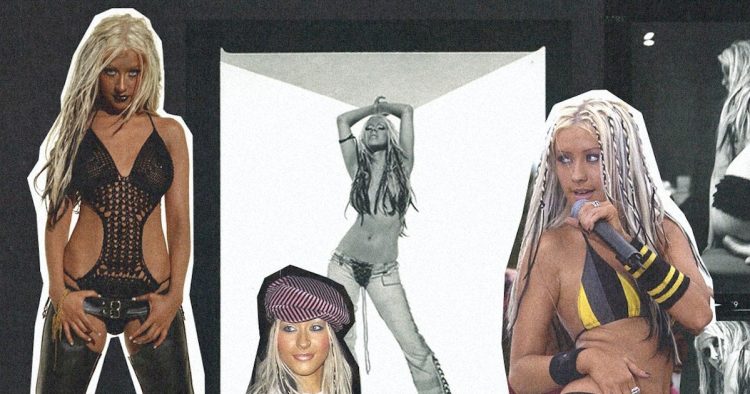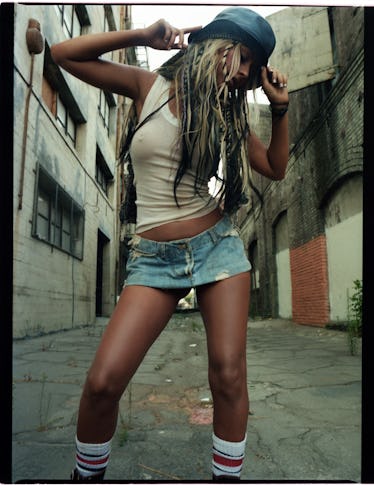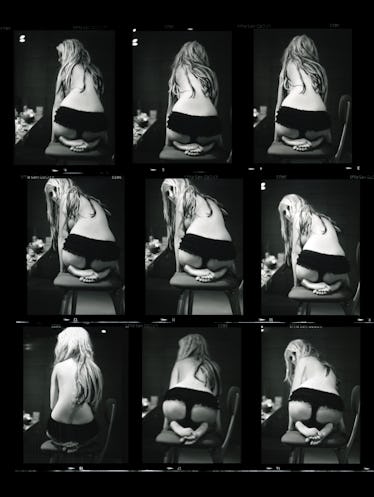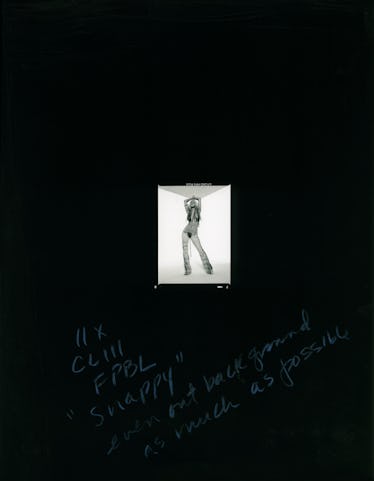“Sorry, I ain’t a diva. Sorry, just know what I want. Sorry, I’m not a virgin. Sorry, I’m not a slut. I won’t let you break me, think what you want,” Christina Aguilera declared on the final interlude of her sophomore record, Stripped. Released 20 years ago, the record was a moment of emancipation for Aguilera—who, until that point, was best known as the blonde-haired, blue-eyed girl next door with bubblegum smash hits like “Genie in a Bottle” and “What a Girl Wants.”
Wildly successful as it was, Aguilera’s early material was not reflective of how the powerhouse vocalist saw herself. After shedding her original management, accusing them of overworking her as a teen and suing them for fraud, the pop princess enlisted industry veteran Irving Azoff to usher her into the next era of her career.
Determined to reclaim her narrative, the artist spent nearly two years burrowed in the studio with a host of new collaborators including top hip-hop producers Scott Storch and Rockwilder, 4 Non Blondes frontwoman Linda Perry, Jane’s Addiction frontman Dave Navarro, The Roots drummer Questlove, Alicia Keys, and Jagged Little Pill producer Glen Ballard. What emerged from these sessions was Stripped, a truly eclectic, 20-track pop extravaganza which saw the singer traverse soul, hip-hop, Latin, R&B, gospel, and rock seamlessly. Aguilera also broke her silence on topics she’d avoided throughout her so-called “cookie cutter” era, from the misogynistic double standards of the music industry to her troubled childhood growing up in a violent home.
Although ridiculed by many at the time for its sexual themes and imagery (Time magazine referred to Aguilera as a “hooker” and Entertainment Weekly labeled her “the world’s skeeziest reptile woman”; she was called a “slut” on national television by both Conan O’Brien and Simon Cowell), the album has gained recognition as an important feminist statement from a young artist determined to take the reins of her career. It’s regarded as a quintessential “coming of age” record that laid a blueprint for young artists who felt they needed a watershed moment in their career, especially those graduating from Disney, Nickelodeon, and other child star machines.
Proving her naysayers of the time wrong, Stripped eventually sold over 12 million copies worldwide. The album went on to be nominated for five Grammys (winning one), a BRIT Award, a MOBO Award and a GLAAD Award for the “Beautiful” video’s portrayal of two gay men kissing and a trans woman getting dressed—groundbreaking imagery for a pop star’s music video at that time, although frequently imitated in the two decades since.
In celebration of this landmark album turning 20, we dove deep into its history and spoke to a plethora of the songwriters, producers, directors, and creatives who helped a 21-year-old, newly christened “Xtina” put this work together (Aguilera declined to participate in this story). What we found was the fascinating story of a young woman who possessed such clarity and determination to create art that was both meaningful and timeless.
RON FAIR (Executive producer and one-time A&R man who signed Aguilera to RCA): Stripped was technically her fourth album—she had also released a Christmas album and her Spanish album, Mi Reflejo. They were all immensely successful so she had earned control. I was already starting to move into the backseat. By then, she was a fully hatched recording beast with tremendous skills, a harmonic subdividing genius, like Beethoven or something.
GLEN BALLARD (Co-writer and producer of “The Voice Within”): Ron Fair asked me to be involved. I was enamored by the incredible vocal gift she possessed, so an invitation to work with her was interesting to me. She’d already been identified as one of the greatest young singers, and she had the protection of Irving, which was pretty powerful. She walked into my Beverly Hills mansion with him and I knew right away, she was special.
ROCKWILDER (Producer of “Dirrty”): Off the back of ‘Lady Marmalade,’ which I produced, we clicked and started hanging out. I didn’t know she was breaking out of her shell and turning into ‘Xtina.’ We were out at a club, getting twisted with her girlfriends, and she heard ‘Let’s Get Dirty’ by Redman. She hops across the table and says, ‘Oh my god, you make me a song like this and we’re outta here!’. That’s why she sings “‘Let’s Get Dirty,’ that’s my jam,” on the song. Before that, I actually wasn’t going to submit for that album because I was a hip-hop producer.
REDMAN (Rapper on “Dirrty”): Christina loved Rockwilder’s track and he was like, ‘Yo, Red should be on it’, so she was like, ‘Go get him.’ I always thought she was hot and could really sing. She was pop but she was also felt in the Black community.
Redman and Christina Aguilera at the 2002 MTV Awards in Barcelona.
Photo by Brian Rasic/Getty Images
SCOTT STORCH (Producer of “Fighter,” “Infatuation,” “Can’t Hold Us Down,” and more): My first day working with Christina was crazy. I’d traded music with Timbaland for a Bentley so I went to pick it up. I was so excited to show up in this fancy car, but it had the wrong license plates on. I got pulled over by the cops, the car got impounded and I had to hitchhike to the studio. Eventually I got there, Christina and I ended up really vibing and started to create something special.
LINDA PERRY (Co-writer and producer of “Beautiful,” “Make Over,” “Cruz” and “I’m OK”): I’d met her, very briefly, rehearsing somewhere and I knew immediately she had a certain darkness. Later I saw her at some club. I thought, ‘God, this girl could make a really great album if she just allowed herself to be vulnerable.’ She was all by herself, sitting behind a velvet rope with a big guy standing there, protecting her. She waved to him to let me in and I was like, ‘I’d use your depression and darkness on this record. Everybody knows Christina Aguilera can sing but I don’t think people understand you can actually feel what you’re singing’. She looked at me like… what the f**k did you just say to me?
After I walked away my friend was like, ‘What did you say to Christina Aguilera?’ And I’m like, ‘Why?’ He said, ‘Because her mouth is still open, and she’s following you with her eyes.’ A week or two later, I get a call saying Christina Aguilera wants to write with you. It was the beginning of a very funny relationship.
MATT MORRIS (Co-writer of “Infatuation,” “Can’t Hold Us Down,” “Loving Me 4 Me,” “Underappreciated,” and “Walk Away”): We were both cast members on The Mickey Mouse Club. After the show, I’d been on the backstage side of the industry, writing songs in Nashville, and in Los Angeles spending time with another colleague from the show, Justin Timberlake, so we were in similar circles. Being someone who knew her before everything ended up being an important part of our collaboration. Perhaps it allowed us to access more vulnerable things together.
STEVE MORALES (Co-writer and producer): I was working on Enrique Iglesias’s album and I got a call from Ron Fair. He liked my work and offered to introduce me to Christina. He told me she was working on her new album and set up a session for us in L.A.
ROB HOFFMAN (Co-writer and producer of “Soar” and b-side “I Will Be”’): Years previously, my writing partner, Heather Holley, and I did Christina’s demo and brought her to Ron Fair, which helped her get her deal with RCA. When Christina went on the tour for the first record, we gave her a care package with a journal and things to take with her on the road. We told her to write it all down because her life was going to be crazy—and it was. We said, ‘Don’t worry about writing songs, just literally write everything down.’
HOFFMAN: On the very first writing session for Stripped, she walked into the studio with her bodyguard who carried this huge Santa Claus-sized bag filled with journals. She’d been documenting everything in her life. There must have been 20 to 30 journals, it was an incredible amount of writing. The person who returned from tour was like a new person—a more mature and, in some ways, a more scarred person as well. We sat on the floor, drank wine, and started talking about ideas.
HEATHER HOLLEY (Co-writer of “Soar,” “Stripped Intro,” and “I Will Be”): She had one idea that was very important to her which became “Soar.” She’d gotten all these letters from fans feeling a pressure to change themselves to fit in, and she wanted to send them a message saying, you don’t need to change a thing.
An outtake of Aguilera during the Stripped photoshoot.
Photographed by Miranda Penn Turin
HOFFMAN: She had very specific themes she wanted to sing about. She even pretty much had the producer roles laid out. She knew who was good at what, and [the label] had given her carte blanche. For the most part, she had a really defined vision for it.
FAIR: She chose the songs and the producers, she wanted to use the hip-hop creators of the day to get the beats. She collaborated on all the looks and videos.
STORCH: She wanted something edgy, soulful, and organic, different from everything on the radio. She wanted to sit at the piano, come up with chords and melodies from scratch to create a new sound. I would just throw shit against the wall and see if I got a reaction out of her. I’ve a lot of memories watching her react to things; it was exciting when you saw she’s excited about something because then the top lines would come easy.
PERRY: Christina has her mood boards and she already knows the look and sound before she even starts going after the music. I don’t allow friends, managers or any entourage in my studio, it’s just a distraction. So she showed up the first day alone, I think she was kind of nervous. She told me ‘I want to call this record Stripped. I want to strip it back and just write some great songs. I want to do something that feels more vulnerable and less produced than ‘Genie in a Bottle’ and those songs I came from.’
STORCH: We wanted to do something rock-driven and anthemic. I did my best impression of a guitar player on the keyboard, these powerful barre chords, and we made ‘Fighter.’ It’s almost like a rock opera record. In the next studio at Conway was Dave Grohl recording with Queens of the Stone Age—they might have even been an influence. I suggested that we bring someone in to add a guitar solo. I was a big Jane’s Addiction fan so we had Dave Navarro come in and he killed it.
ROCKWILDER: When she first heard the track, she felt like it sounded a little too like ‘Let’s Get Dirty,’ so she was hesitant. But when it was time for her to choose a record that introduced her new look and vibe, the track ended up coming back up. The label loved it and said, ‘This is the record that you need to break out.’
HOLLEY: She played ‘Dirrty’ for us and we were like, ‘Whoa, that’s… different from your past.’ She had such a professional mind about it. She felt it was what she had to do to set herself apart from Britney and other young artists, to show something totally different that surprises people.
BALLARD: The intention was to just write a song that we felt. I sat at my piano and we just made it up as we went along. When the smoke cleared, we had this song called ‘The Voice Within.’ It’s about when you’ve been abandoned in the real world, there’s still this thing inside you that, if you listen to it, it’s your best friend.
PERRY: She had asked me to play something for her and I had just finalized the lyrics of ‘Beautiful.’ She was like, ‘Can you make a demo and give me the lyrics?’ I was like, ‘Why?’ She said, ‘Because I want that song for my album.’ I’m thinking, you can’t sing a song like this, you are beautiful—but when I heard her sing the demo, I got goosebumps.
She came back to lay down the vocal and asked if she could bring a friend ‘cos she was nervous. I think he was one of her dancers. Anyway she put headphones on, looked at her friend who was staring at her and said: ‘Don’t look at me.’ As soon as she said that, I knew the song was for her because she was so vulnerable. And I knew I was going to leave that at the top of the song.
MORALES: I think she was in some sort of a relationship with Dallas Austin at that point, and something went wrong which I can’t speak on, but it bothered her a lot. He might have hurt her and that was her motivation for writing “Get Mine, Get Yours.” She was like, ‘You know what, this should just be a get mine, get yours kind of thing.’
MORRIS: With Christina, we didn’t write a song from start to finish. I’d share partial lyrics or she might start with an idea. One song we began together that actually didn’t end up on the album was ‘Miss Independent’ which Kelly Clarkson later recorded. That started with Christina having this idea around the title ‘Miss Independent.’ I wrote some verses, brought them back. Christina then built upon it with other people. She’d guide and lead that process, so if it wasn’t where she wanted it to be, often I’d leave it with her, like, ‘See if you can make it something here.’
BALLARD: The making of ‘The Voice Within’ is one of the greatest all-nighters of my life. We recorded at The Record Plant in Hollywood, I had so many great musicians in the studio. We cut the track at around 4 PM. Christina came in at midnight with an entourage of 20 beautiful people. She was warming up, writhing through it, then she went out and sang the song at about 4 AM and just burned the house down.
HOLLEY: All the teams were in different rooms at Conway Studios at the same time. Imagine this hub of artists all working toward this beautiful project. It was so cool going into another room and hearing the Scott Storch songs, and then Linda Perry was in the next room making ‘Beautiful.’ They don’t make albums like that anymore.
FAIR: There may have been a misunderstanding between us at times, with me being an older man trying to do a creative project with a younger woman who was finding her own voice. I think me being so engaged in the recording process could have been misunderstood for control but my only motivation was always to keep it all elevated.
PERRY: I had to put some rules down with her. I had a start time of 10 AM and sometimes she wouldn’t even show up till 10pm. One day, she did that to me, I picked up my stuff and started walking out. Her manager was like, ‘Where are you going?’ I’m like, ‘I’m out. I got a life. I’m not gonna sit here at the studio waiting for an artist to show up, it’s their career.’ Christina got all upset, and I said, ‘and I’m taking ‘Beautiful’ with me!’ They looked at me like, ‘No!’ Then Christina came out, she was crying and apologizing. I’m like, ‘Okay, let’s not do that again’. And she never did.
MORALES: I remember there was a big kerfuffle with her and Linda Perry because Linda didn’t want all the riffs in ‘Beautiful.’ I got to see them argue. It was amazing. I saw bottles flying!
FAIR: As the producer, Linda saw it as her movie. Sure, Christina’s starring in it but it was Linda’s movie. They had two different vantage points. Linda’s all about spontaneity and how things feel, Christina, on the other hand, is a studio animal. She’s highly cognitive of everything that’s recorded, wants to do numerous takes to perfect a vocal and do microsurgery to change notes here or there until she satisfies her own bar. So you’ve a perfectionist and someone wanting to create a spontaneous combustion together. If there was disagreement, it was that Linda wanted to keep the first take because she felt like she captured something with Christina that couldn’t get any better with more takes.
An outtake of Aguilera for Stripped.
Photographed by Miranda Penn Turin
PERRY: I’m a controlling person, Christina will definitely validate that. We bumped heads because we were both very controlling. There was one song I can’t remember now, I was like, ‘Oh my god, I can’t stand that song. You’re really gonna put that on the record?’ She would laugh at me like, ‘Linda, I love this song.’ I’m like, ‘I know, but it sucks.’ But she fought for it because she believes in everything she puts her voice to. That’s what I love about Christina—she really doesn’t care.
MORALES: At a session in 2001, Ron Fair screamed across the table: ‘Look, they’re gonna give you a $5 million advance if you can hurry up and get this album out faster.’ The label was begging her to put it out but she wouldn’t let them. She was like, ‘F**k you. I’ll be ready when I’m ready.’ She was more concerned about being real than fulfilling corporate needs. It was her way or no way, and her way led to a diamond-certified album.
PERRY: We were at Enterprise Studios doing ‘I’m OK’ and she was in a really sad mood. I put this little blurb of a movie about sexual wrongdoings in the vocal booth and it made her cry. So she was on the floor crying… This is probably the most selfish thing ever, but as she was crying, I quietly lowered the microphone down to where she was, and pushed record. I said: ‘Just use it for the song’. You can hear her crying on the record.
MORRIS: At that time, Christina was being shamed and belittled by male artists for her sexuality, called out in songs and subjected to misogyny. We tried to write about that in ‘Can’t Hold Us Down.’ My contributions came from a similar perspective of being marginalized as a queer person and speaking to your oppressor with frustration and anger.
MORALES: She could be mean or tough. She has a way of shutting you down, she’ll walk away from you or look at you like you’re f**king crazy. That little lady is nothing to f**k around with. I had to wait four weeks for her to even sing the song. I’m not saying she’s unprofessional—as a producer, if that’s what you want, then you will wait for Ms. Aguilera to be ready. Because when she was ready, we sold 12 million albums.
HOLLEY: She didn’t want to settle. I remember tearing my hair out trying to come up with new ideas for ‘Soar.’ I’d have something and she’d say ‘It’s good, but it can be better.’ It was tough but inspiring.
MORALES: I mentioned I was with Britney the day before, she almost left. She was like, ‘Oh, you working with her? I’m leaving.’ She didn’t care too much about Britney but she was like, ‘I thought you were working with me though?’ She’s not some little fluffy girl, believe me, that’s one of the toughest women I’ve ever worked with in my life, and I’ve worked with everybody. Christina Aguilera, I will say, is the most special of all.
Christina Aguilera performs for MTV’s TRL Presents in NYC, 2002.
Photo by Theo Wargo/WireImage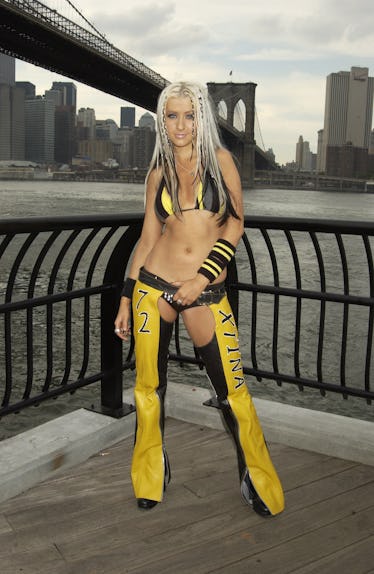
Armed with an arsenal of deeply personal new material under her belt, the singer next turned her attention to another element of her artistry she felt was in dire need of an overhaul: her self-described “cookie-cutter,” bubblegum-pop-girl image. In a makeover that would cause a Bangerz-era Miley Cyrus’s eyes to water, Aguilera unveiled in 2002 a stark new look through the double-punch of the Stripped album cover on which she appears topless, followed by the David LaChapelle-directed music video for ‘Dirrty.’
Christina Aguilera at the 2002 MTV Video Music Awards on August 29, 2002.
Photo by Mark Mainz/Getty Images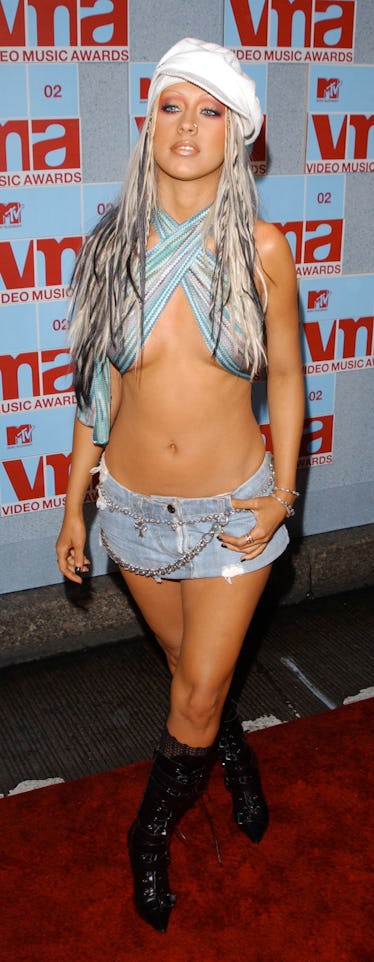
FAIR: She may dispute this, but ‘Xtina’ came from me. I was sending so many emails back then and I needed a way to abbreviate her name because I wrote it 17,000 times a day. Christmas is Xmas, so I started using Xtina.
MIRANDA PENN TURIN (Photographer who shot the album inlay): The whole notion of Christina taking over her image was really uncommon at the time. She’d been a product of these humongous corporations and at 21, she didn’t want to be that anymore.
ROCKWILDER: Me and Red were smoking weed in the trailer on the ‘Dirrty’ set. I look out as she walked past wearing these little underwear, boots, and a big ol’ helmet with ‘XTINA’ spray painted on the back. I’m like oh my god… Redman’s sitting there rolling, like, ‘What happened?’ I said, ‘This ain’t ‘Genie in a Bottle’… She’s naked!’ Now I’m like, ‘Oh God, this is where it goes downhill. It’s over.’ But then the video’s going and I start to see something. She’s stepping out, it’s about to go down. I started to be the supporter like, ‘This is gonna be hot.’
PENN TURIN: We met at the Azoff Management offices and threw a bunch of tears onto the table and talked about our favorite music videos, photographers, and artists. Christina wanted something that was raw, sexy, unfettered. We went with the grainy black and white images. There was no digital then; it was all analog.
A tear sheet proof from Aguilera’s Stripped shoot.
Photographed by Miranda Penn Turin
REDMAN: I first met her on the video. It was lit, like a collage of different things with the same feel as my ‘Let’s Get Dirty’ video—more expensive though! The director really went for it, it was like a rave.
ROCKWILDER: David LaChapelle was amazing to create that little hell hole that he created. I wouldn’t wish that club on anybody.
HOFFMAN: Heather and I were on the ‘Dirrty’ set, I vividly remember turning to Alison Azoff and saying, ‘Alison, are they gonna play this on MTV?’. She was like, ‘Shhh…’
ROCKWILDER: I was very concerned but I forgot how big of an artist she was. And she didn’t care so I rolled with it. I was in the Bronco with her, like let’s go, blood on our hands.
PENN TURIN: It was very collaborative between Christina, me and [stylist] Trish Summerville. We shot the topless cover shot first though we didn’t know it would be the cover at the time. We probably did 20 different setups over two days.
The artist’s new look and sound ensured she remained a tabloid darling, and while the ‘Dirrty’ video was a mainstay on TRL for months and a European smash hit, commercially, the song underperformed in the U.S., failing to break the Top 40 on the Billboard Hot 100. With a highly anticipated album to sell, Aguilera’s camp quickly pivoted the campaign to show the other sides of the artist. Firstly, with ‘Beautiful,’ and later with the rock-tinged self empowerment banger ‘Fighter,’ the Lil’ Kim-assisted anthem ‘Can’t Hold Us Down’, and the cinematic piano ballad ‘The Voice Within,’ each single helping to display the breadth and versatility of both Aguilera and Stripped.
FAIR: ‘Dirrty’ started to falter on radio; there was this narrative of, ‘She’s so threatening, the sexuality’s too much, I don’t want my daughter to see this,’ all this crap. The decision was made inside RCA to move to the second single. I learned later that moving on prematurely from ‘Dirrty’ had a high cost for the album’s forward momentum. The record was in the Top 20 on radio but there was some pushback.
A proof for the cover of Stripped.
Photographed by Miranda Penn Turin
PERRY: When you say ‘stripped,’ and you release this overproduced track, like ‘Dirrty,’ it’s like, what happened to ‘stripped’? Oh, you mean ‘stripped’ as in, you’re naked? People were confused. But when they heard ‘Beautiful,’ they got it. It was smart to flip so fast, it probably saved that record.
JONAS ÅKERLUND (Director of ‘Beautiful’ music video): I was a bit of a snob back then. I was more into rock and roll, so I passed on working with artists like Christina and Britney for quite some time. When I heard ‘Beautiful,’ I was like, ‘Shit, I have to do this, this song is so good’. It was a big game-changer for me because I learned I can do stuff that’s not necessarily in my world and it can be magical.
FLORIA SIGISMONDI (Director of ‘Fighter’ music video): Christina approached me at a great time in her evolution; she was ready to experiment and do something more conceptual with her look. She was up for anything and I loved that. She has the most beautiful translucent skin which I wanted to highlight. It was the first video that pushed her into blue tones, I don’t think she had been seen that way before.
ÅKERLAND: We had a simple idea: a day in life from different perspectives and struggles. We wanted simplicity: a bare room, no furniture. That house was in really bad condition. I insisted that we put in a new carpet, so she could lie down and roll around without getting dirty because it was filthy. We always wanted it to be set that night because there’s something extra lonely at night.
SIGISMONDI: In the video, she starts in an inky black world and then blooms into an ethereal moth queen before becoming her new stronger self. It felt quite dark for her, but she was really daring and trusted me all the way. Jeremy Scott designed the moth dress. I wanted something that felt like a cocoon falling apart. We used gigantic live moths to symbolize rebirth and transformation. I was terrified of them.
ÅKERLAND: The LGBT representation was both of our ideas. We listed all these different issues and that was part of it. We weren’t thinking, ‘Oh, wow, we’re gonna do two guys kissing and it’s gonna break the Internet.’ It just felt like the most natural thing to do. Over the years, I’ve met people who tell me it’s the first gay kiss they ever saw, and people sent me letters.
PERRY: I’m not gonna lie, when I first saw the video I was a little thrown. I felt like it was making too much of a statement and was getting in the way of the song, which did that on its own. But you know what? She knew what she was doing, and it worked. Everybody loves that video.
FAIR: ‘Beautiful’ comes out, immediately becomes a gigantic hit and overtakes ‘Dirrty’ on the chart. In the meantime, research came back on ‘Dirrty’ showing that it was a hit and they’d moved off it too early. When I look at the story of Stripped, I think it would have been very different if they had the courage to stick with ‘Dirrty.’ We would have had back-to-back smash hits instead of just ‘Beautiful.’ But RCA was not an edgy company and the people working there were not moving culture forward. They were putting records out.
The album’s five singles, plus a two-year promotional cycle which included a Saturday Night Live hosting slot, a joint concert tour with Justin Timberlake, and a seemingly never-ending stream of magazine covers, helped propel Stripped to blockbuster status, going five times platinum in the United States and shifting over 12 million units worldwide.
Twenty years later, the era’s impact can still be seen in pop culture, be it through shots of queer embrace in music videos like Katy Perry’s ‘Firework’ or the sight of leather chaps and black and blonde braids on Kylie Jenner’s Instagram circa Halloween 2016. Perhaps most significantly, it is sustained through the generation of young men and women who were first introduced to concepts like sex positivity and self empowerment through the record.
DEMI LOVATO (Artist and subsequent collaborator): Songs like ‘Beautiful,’ and especially its music video showcasing queer youth, have had a lasting impact on me. ‘Dirrty,’ its music video, and Christina’s use of her alter ego Xtina went on to inspire me in my later years to lean into sexual liberation and hold nothing back.
PENN TURIN: I really think she paved the way. Before her, only Madonna had that kind of a voice culturally, and she came out of the gate that way. Christina had to take her power from humongous corporations and she never backed down. She became a role model, not just for other musicians, but for anyone trying to take their power and be authentic.
STORCH: Stripped was groundbreaking, it had depth and it redefined what a pop album can be. I’m proud I was able to be involved in that album because, like all the best music, it has no expiration date. It doesn’t sound like whatever was popular at the time. We were more than just artist and producer, we were really close friends and had an amazing experience making that album.
ROCKWILDER: I can’t believe the response ‘Dirrty’ gets, even now. I’ve been part of a lot of great albums but Stripped put me in a different lane. It will go down in history as an album where we took a risk and it worked.
ÅKERLAND: I’m very proud of ‘Beautiful’. My children listen to that song. The fact that we created something that still touches people today is incredible because videos are not supposed to live forever. If that was the only video I ever did, I would be happy.
MORALES: I’ve helped sell 80 million albums around the world from all of the biggest stars, but this album is legendary. It defines the era, and it will last forever because every song mattered and she didn’t let the Hollywood shit get to her. She just sat down, like a Latina, and did her thing.
PERRY: Stripped’s legacy is independence. She took a step into independence and succeeded. A lot of girls were able to see that independence equals power, because let’s face it, most of the time this business is not great for women.
LOVATO: It’s an album that I go back to over time and continue to draw inspiration from. Sonically, the blend of soul, pop, Latin, and R&B genres proved female vocalists don’t need to be constrained to just one sound. Working with Christina for her 2018 single “Fall in Line” was a dream come true for 10-year-old Demi, who would belt her heart out in her room while listening to Stripped.
BALLARD: It’s a seminal moment in my career. I’ll always think of this record as one of my great achievements. I’ve had hundreds of young women and men say to me, ‘The Voice Within’ kind of saved my life.
FAIR: If you can understand the significance of the album as an art form in those days, then what you see with Stripped is an artist in full bloom, embracing a kaleidoscope of colors and feelings available for her to express herself. It’s wonderful to look at the world at that time through Christina’s eyes on that album. It really was her baby, when I look back on it now I’m super proud of it, and more importantly proud of her.
An outtake of Aguilera for Stripped.
Photographed by Miranda Penn Turin
The interviews in this article were edited and condensed for clarity.
Source by www.wmagazine.com
